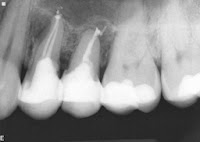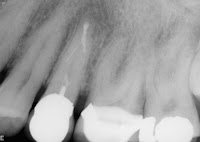 |
| Pre op #10 |
Dentist attempted to locate the canal, could not. Advised patient a possible apicoectomy may be necessary.
 |
| File film #10 polarized view |
Using ultrasonics I located the canal and cleaned. A polarized view will sometimes more clearly define the end of the file to the apex of the tooth.
 |
| Immediate post op #10 polarized view |
Again, this polarized view clearly demonstrates the relationship of the root canal filling to the apex of the tooth. Please note: lateral incisors typically have a curve in the apical end of the root.
Comments: Even though canals cannot be initially negotiated, they are always there to some degree. It is just a matter of finding them. Granted, some canals are not negotiable, and surgery may be necessary. Generally surgery is not the first choice in root canal therapy.


















